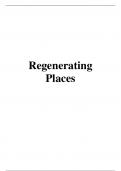Regenerating
Places
,London Docklands Regeneration
History
East London’s history is characterised by immigration, particularly from the late eighteenth century. Jewish
immigration was particularly prevalent as demonstrated by the fact that in the 1870s and 1880s, 150 synagogues were
built. From the nineteenth century, expansion of London led to the overcrowding of the area. There was a particularly
high proportion of poor people in the population with high levels of crime. Cockney English is particularly
recognisable.
The London Docklands was once the largest and most successful trading post in the work, originating with the West
India Docks in 1802. More docks were later formed in the East India Docks, Millwall Dock, Surrey Docks and then
the Royal Docks. At one point they employed thousands of people and international trade, warehousing and related
trade made the UK one of the most powerful and wealthy countries in the world.
Decline of East End Docks
During World War II, the Docklands suffered significant damage from bombings, which heavily damaged the British
economy. One on night, 380,000 tonnes of timber was destroyed in the Surrey Docks.
Despite a brief resurgence in the 1950s, the Docklands were almost empty by the 1980s. The East End docks declined
for several reasons:
● The East End Docks were too close to Central London that the Thames River was not deep enough for
container ships.
● As the container ships became larger, there was no need for workers to unload them as huge cranes were used
instead.
● This lead to unemployment between 1978 and 1983; over 12,000 jobs were lost and over 60% of adult men
were unemployed in some parts of East London.
● Almost 83,000 jobs were lost in the surrounding boroughs of Greenwich, Lewisham, Newham, Tower
Hamlets and Southwark.
● The dockworkers and their families were already poorly paid and a lot of their housing was social housing
rented from local councils.
● Industries nearby the port in East London’s Lea Valley had to close as ships were unable to import raw
materials or export finished goods.
● Trucks, ferries and aeroplanes were exporting increasingly more goods.
● This lead to a decline in population between 1971 and 1981 of ~100,000 people.
The shipping industry moved to deep-water ports, such as Tilbury and Felixstowe. Between 1960 and 1980, all of
London's docks were closed, leaving around eight square miles (21 km²) of derelict land in East London.
Summary:
● The London Docklands were very successful in the 19th century.
● Thousands of people were employed and it made the UK extremely wealthy.
● The Docklands fell into decline by the 1980s:
o The River Thames was too shallow for container ships.
o Huge cranes (machinery) were used to unload the ships.
o 12,000 jobs were lost and 60% of adult men were unemployed.
o Nearby industries fell into decline due to the lack of trade.
o More goods were being transported by aeroplanes, ferries, etc.
● Decline in population of ~100,000 people.
, London Docklands Regeneration
Effects of Decline
This decline had several effects:
● With high levels of unemployment in most cities in the UK, inner cities areas were viewed as places with little
economic potential.
● This meant there was little investment in these areas, leading to a decline in environmental quality and crime
rose significantly (1975-85):
o Burglary increased by 68.2%.
o Theft increased by 48.6%.
o Violent crime increased by 71.4%.
o There was a total increase of crimes by 71.5%.
● High levels of deprivation and ethnic/community tensions led to riots in Liverpool, Leeds and London in
1981.
● London was left with practically no commercial infrastructure; the UK government had to regenerate a whole
industry by making the docklands an appealing place to work and live in once again.
London Docklands Development Corporation
The planning for the redevelopment of the London docklands became complicated due to too many landowners, so the
London Docklands Development Corporation (LDDC) was formed in 1981.
● The plans were to develop the area into a secondary office location, due to its close proximity to the City of
London.
● Additionally, the docklands would be supported by the riverside real estate development to house this new
wave of city workers and transport.
● In the 1980s, most housing in the Docklands was rented from local councils at low cost.
● Then the Right to Buy scheme was introduced by the government. This gave those living in council housing
the right to buy it at a reduced price.
● Consequently, most East End housing was transferred from the public to the private sector; this greatly
reduced the amount of available social housing.
● The redevelopment scheme was known as market-led regeneration. The LDDC was given extensive planning
powers, which bypassed the local councils in Newham, Tower-Hamlets and Greenwich.
● With planning permission granted by 1991, companies could obtain tax breaks on new buildings.
● These tax incentives were designed to attract investors.
Summary:
● The decline of the London Docklands gave it a very poor image.
● With little economic potential, there was little investment.
● Crime rose significantly between 1975 and 1985.
● The LDDC was formed in 1981 to coordinate the redevelopment of the Docklands.
● The area was to be redeveloped into a secondary office location.
● The Right to Buy scheme allowed council housing to be bought at reduced prices.
● The LDDC was given extensive planning powers.




